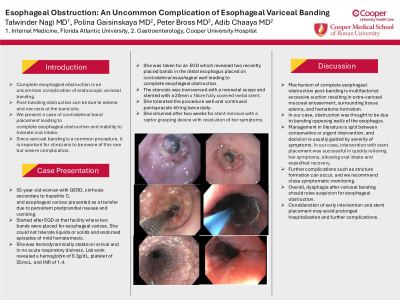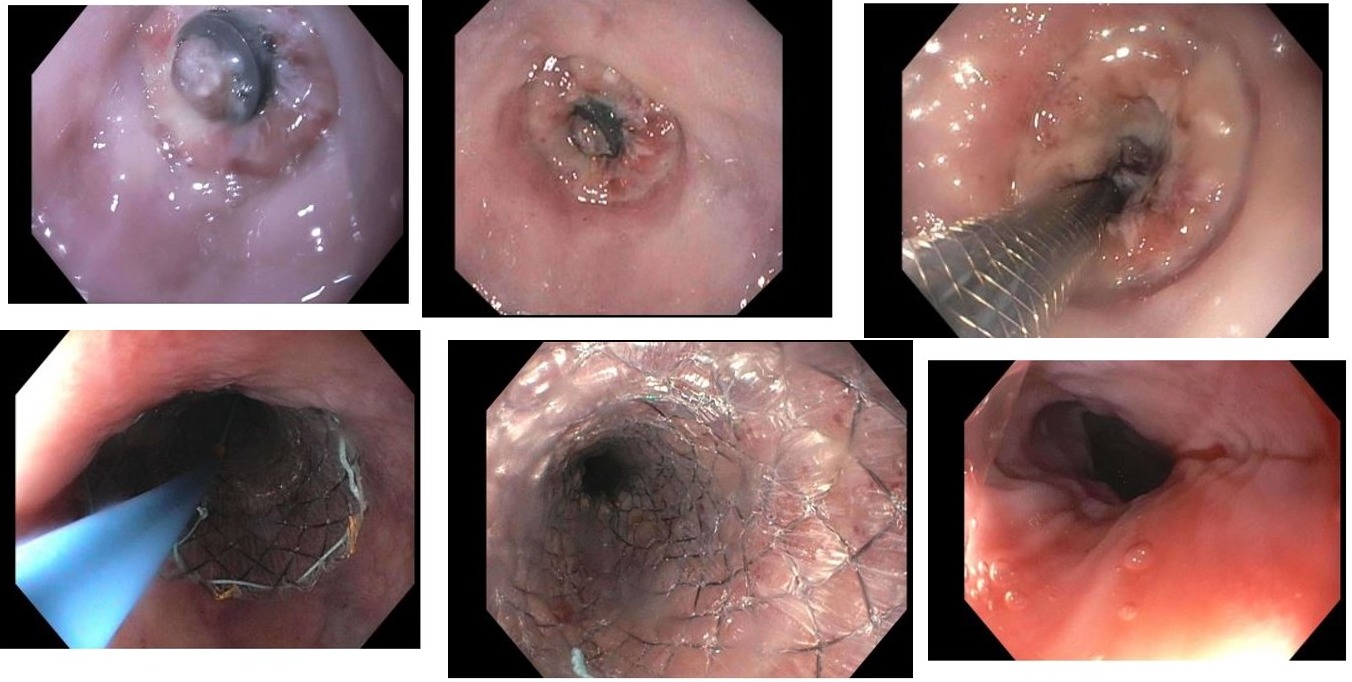Monday Poster Session
Category: Interventional Endoscopy
P2848 - Esophageal Obstruction: An Uncommon Complication of Esophageal Variceal Banding
Monday, October 28, 2024
10:30 AM - 4:00 PM ET
Location: Exhibit Hall E

Has Audio

Talwinder Nagi, MD
Florida International University
Boca Raton, FL
Presenting Author(s)
Talwinder Nagi, MD1, Polina Gaisinskaya, MD2, Adib Chaaya, MD2, Peter J. Bross, MD2
1Florida International University, Boca Raton, FL; 2Cooper Health Gastroenterology, Camden, NJ
Introduction: Complete esophageal obstruction is an uncommon complication of endoscopic variceal banding. Post-banding obstruction can be due to edema and necrosis at the band site. We present a case of contralateral band placement leading to complete esophageal obstruction and inability to tolerate oral intake. Since variceal banding is a common procedure, it is important for clinicians to be aware of this rare but severe complication.
Case Description/Methods: A 55-year-old woman with GERD, cirrhosis secondary to hepatitis C, and esophageal varices presented as a transfer from another facility due to persistent postprandial nausea and vomiting. These symptoms started after EGD at that facility where two bands were placed for esophageal varices. She could not tolerate liquids or solids and endorsed episodes of mild hematemesis. The patient was hemodynamically stable on arrival and in no acute respiratory distress. Lab work revealed a hemoglobin of 9.3g/dL, platelet of 55mcL, and INR of 1.4. She was taken for EGD which revealed two recently placed bands in the distal esophagus placed on contralateral esophageal wall leading to complete esophageal obstruction. The stenosis was transversed with a neonatal scope and stented with a 20mm x 15cm fully covered metal stent. She tolerated the procedure well and continued pantoprazole 40 mg twice daily. She returned after two weeks for stent removal with a raptor grasping device with resolution of her symptoms.
Discussion: The mechanism of complete esophageal obstruction post-banding is multifactorial including excessive suction resulting in extra-variceal mucosal encasement, surrounding tissue edema, and hematoma formation. In our case, obstruction was thought to be secondary to banding opposing walls of the esophagus. Management in literature is split between conservative or urgent intervention, and decision is usually guided by severity of symptoms. In our case, intervention with stent placement was successful in quickly relieving her symptoms, allowing oral intake and expedited recovery. Further complications such as stricture formation can occur, and we recommend close symptomatic monitoring.
Overall, dysphagia after variceal banding should raise suspicion for esophageal obstruction. Consideration of early intervention and stent placement may avoid prolonged hospitalization and further complications.

Disclosures:
Talwinder Nagi, MD1, Polina Gaisinskaya, MD2, Adib Chaaya, MD2, Peter J. Bross, MD2. P2848 - Esophageal Obstruction: An Uncommon Complication of Esophageal Variceal Banding, ACG 2024 Annual Scientific Meeting Abstracts. Philadelphia, PA: American College of Gastroenterology.
1Florida International University, Boca Raton, FL; 2Cooper Health Gastroenterology, Camden, NJ
Introduction: Complete esophageal obstruction is an uncommon complication of endoscopic variceal banding. Post-banding obstruction can be due to edema and necrosis at the band site. We present a case of contralateral band placement leading to complete esophageal obstruction and inability to tolerate oral intake. Since variceal banding is a common procedure, it is important for clinicians to be aware of this rare but severe complication.
Case Description/Methods: A 55-year-old woman with GERD, cirrhosis secondary to hepatitis C, and esophageal varices presented as a transfer from another facility due to persistent postprandial nausea and vomiting. These symptoms started after EGD at that facility where two bands were placed for esophageal varices. She could not tolerate liquids or solids and endorsed episodes of mild hematemesis. The patient was hemodynamically stable on arrival and in no acute respiratory distress. Lab work revealed a hemoglobin of 9.3g/dL, platelet of 55mcL, and INR of 1.4. She was taken for EGD which revealed two recently placed bands in the distal esophagus placed on contralateral esophageal wall leading to complete esophageal obstruction. The stenosis was transversed with a neonatal scope and stented with a 20mm x 15cm fully covered metal stent. She tolerated the procedure well and continued pantoprazole 40 mg twice daily. She returned after two weeks for stent removal with a raptor grasping device with resolution of her symptoms.
Discussion: The mechanism of complete esophageal obstruction post-banding is multifactorial including excessive suction resulting in extra-variceal mucosal encasement, surrounding tissue edema, and hematoma formation. In our case, obstruction was thought to be secondary to banding opposing walls of the esophagus. Management in literature is split between conservative or urgent intervention, and decision is usually guided by severity of symptoms. In our case, intervention with stent placement was successful in quickly relieving her symptoms, allowing oral intake and expedited recovery. Further complications such as stricture formation can occur, and we recommend close symptomatic monitoring.
Overall, dysphagia after variceal banding should raise suspicion for esophageal obstruction. Consideration of early intervention and stent placement may avoid prolonged hospitalization and further complications.

Figure: EGD depicting fully covered metal stent placement and post stent removal
Disclosures:
Talwinder Nagi indicated no relevant financial relationships.
Polina Gaisinskaya indicated no relevant financial relationships.
Adib Chaaya indicated no relevant financial relationships.
Peter Bross indicated no relevant financial relationships.
Talwinder Nagi, MD1, Polina Gaisinskaya, MD2, Adib Chaaya, MD2, Peter J. Bross, MD2. P2848 - Esophageal Obstruction: An Uncommon Complication of Esophageal Variceal Banding, ACG 2024 Annual Scientific Meeting Abstracts. Philadelphia, PA: American College of Gastroenterology.

